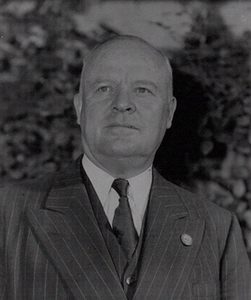MAW, HERBERT BROWN

Herbert B. Maw
Herbert Brown Maw was born in Ogden, Utah, in 1893 to Emma Brown and Ephraim Goodman Maw. He later moved with his family to Salt Lake City where he attended LDS High School and the University of Utah Law School. He received a master's degree and a doctor of law degree from Northwestern University. During World War I he served as a Mormon chaplain in the military. He married Florence Buehler in 1921, and they had four children.
Maw taught speech and political science at the University of Utah and was dean of men from 1928 to 1936. He served for ten years in the state senate and was senate president for four years. He promoted direct primary elections, old-age assistance programs, and government control of public utilities. A member of the Democratic party's liberal wing, he failed in three attempts to win his party's gubernatorial nomination against conservatives, including Governor Henry Blood, whom he challenged in a bitter convention fight in 1936. When the state's first direct primary was held in 1940, Maw defeated Henry D. Moyle for nomination as governor, and went on to win election as Utah's eighth state governor over Republican Don B. Colton, a former congressman.
Maw's top priority in 1941 was the reorganization of numerous commissions, boards, and bureaus under the direction of a handful of departments, one of which, Publicity and Industrial Development (PID), Maw saw as promoting tourism and new business. The PID department built access roads to scenic attractions and film locations in southern Utah, and also built a natural history museum in Vernal; but funding for PID remained controversial throughout Maw's administration.
During World War II, Maw helped to lead a successful campaign to attract major military facilities and related war industries to Utah; this created thousands of jobs, reviving the economy and enabling the state to retire its debts. In 1944, with support from conservative Democrats being only lukewarm, Maw supporters created a controversial pamphlet, Morals and the Mayor, that purported to expose lax law enforcement in Price under its colorful mayor, J. Bracken Lee, the Republican nominee. Maw eked out a slim 1,056-vote victory, unsuccessfully contested by Lee.
Stated goals during Maw's second term were economic security and equal civil rights for all citizens; however, by 1947 he was warning the legislature about the cost of new health, education, and welfare programs. He promoted a major highway building program and approved creation of a state water and power board to oversee development of Colorado River water in Utah. Funding requested by Maw for the pioneer centennial celebration in 1947 attracted many tourists to the state and built the "This Is the Place Monument" at the mouth of Emigration Canyon.
Public criticism of a state welfare system that lent itself to political interference, a highly publicized case against two state liquor system employees, the dissatisfaction of conservative Democrats, and a campaign letter to fellow Mormons that backfired, all helped lead to Maw's defeat by Republican J. Bracken Lee in 1948.
Maw sought a U.S. Senate seat in 1956 but was defeated in the primary. He continued active in private life and maintained a private law practice until he was into his nineties. He died on 17 November 1990.
Disclaimer: Information on this site was converted from a hard cover book published by University of Utah Press in 1994. Any errors should be directed towards the University of Utah Press.